|
Leopard seals are named after their spotted coat. They have a dark grey dorsal and are lighter along the underside with a white spotted throat. Like their feline name-sake, these seals are vicious hunters and are the most ferocious of all seals. They are sleek and elegant in the water, built for speed and strength. They have strong foreflippers and a reptilian head. Their fur is slick and smooth, designed to limit resistance in the water. These seals have excellent eyesight and a superb sense of smell, even in the water. And their hearing can be five times more sensitive than humans. They have short, hardly noticable whiskers, which helps the seal detect movement in the water. The seal's head is basically all teeth, jaw, and muscle with no forehead. This gives the seal much power in it's bite. The size of the seals is 10 feet in males and 11 feet in females. Males weigh up to 320kg while females weigh 370kg.
|
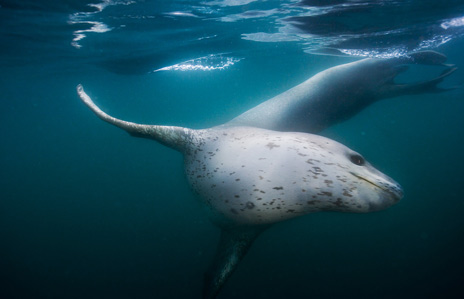 A female Leopard Seal shows off to the photographer. The spots where the seal got it's name is clearly seen. |
|
Leopard seals are the apex predators of the Antartic. They have virtually no fear, except for those of orcas, or killer whales. These oversized dolphins are the seals only threat. These intellegent seals are bold and highly playful but there is a fine line between curiousity and predatory instincts. Adults are solitary animals, prefering to go at life alone and coming together only to breed. Their swimming habits is slightly different from other seals. They use their hindflippers like other seals, but also employ their foreflippers, like sea lions and fur seals. This gives manuverability. Also, unlike most other seals, leopard seals are not deep divers, prefering to stay near the surface where their prey is found. They can hold their breath for 15 minutes. Little is known of the leopard seal's reproductive behavior. But scientist knows that females dig burrows to give birth after a 9 month gestation period. She protects the pup until it can fend for itself. Lifespan is unknown, but many believe it can be up to 27 years or more.
|
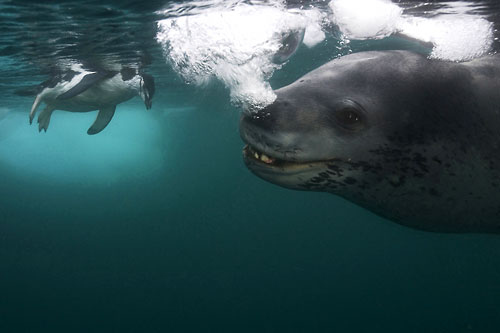 A Leopard Seal is examining the catch it's about to play with. The penguin isn't dead, merely stunned and exhausted. The seal blows bubbles in a threat, as it was hoping for a chase. |
|
Leopard seals are on the top of the food chain, fed on only occasionally by killer whales. These seals feed on krill, penguins, seabirds, fish, squid, and even other seals. They have interlocking back teeth to capture krill, grabbing a mouthful and squeezing the water out to swallow the trapped crustaceans. These seals also go after fish and squid in a typical seal manner, charging through a school and picking up any that comes within reach. They also attack and feed on other seals, mainly young crabeater seals. Vertical scars can be seen on adult crabeaters that are reminders of their terrifying youth. Preying on skuas and other seabirds is not very common, but a seal will take it if the opportunity presents itself. But, leopard seals are by far more famous for preying on penguins. They are the bird's main threat and adapt several tactics to capture their speedy prey. Often they lie in wait for the birds to build their confidence enough to plunge into the water. The seals then chase their chosen victim. Or these seals might wait on land for penguins to leap out of the water. The birds, mostly Emperor penguins, won't see the seal until it's too late and they're snatched up in it's waiting jaws. Or it'll come onshore to chase the penguins into the water for the real chase. Don't feel much on being land-bound? Some seals leap out ot the water to snatch penguins that wait at the edge of an iceberg. Or find a bird walking on thin ice, then break the ice and drag it down before it knows what hit it. After making it's catch, the seal thrashes the struggling bird along the surface of the water to peel off the bird's tough outer skin. But sometimes, they enjoy playing with their victim before killing it. In fact, most penguins don't die of the wounds, but of stress and exhaustion. During this 'play session' the seal shakes the penguin like a rattle, half drowning it, then releases the penguin, only to catch it again and again. Also, one in Australia was found with a platypus in it's stomach. It seems that these seals will eat anything they can overpower. |
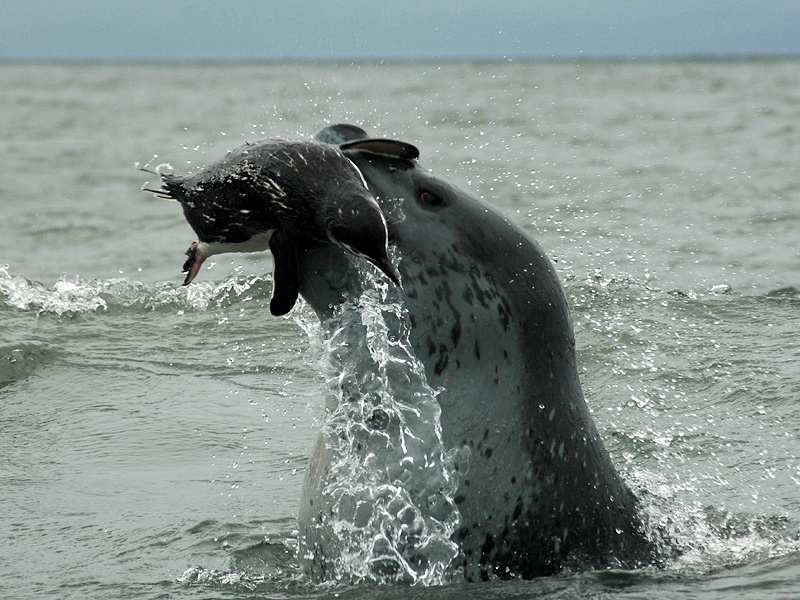 Here, a Leopard Seal is playing with a penguin it caught. It will kill the bird once it gets bored with it. |
|
There is one leopard seal to ever be in captivity and it's in Toronga Zoo in Sydney Australia. In all of history that we've discovered the seal, only one person has been killed by these immense predators. The Biologist was dragged under the water by a leopard seal to her death, drowning when the seal refused to let her go. These seals are aggresive in the water, displaying teeth in a gaping jaw to threaten any human who enters their territory. They also been known to nip at the feet of walking people through thin ice, which is actually a tactic that they use to capturing wandering penguins. They also puncture inflatable boats, but other than one accident, there has never been a human fatality caused by these seals. On land, where they rest on floating ice, the seals show little concern for humans. They just snooze as if we weren't there, allowing for humans to even approach and touch them, though that's not recommended. If a diver enters the water, the seal finally shows intrest and follows the lead. One Biologist attracted the attention of a female leopard seal that repeated seeked him out to interact. She even slept by his boat at night. Once, she captured a young penguin and tried to offer it to him. A quote from this lucky Biologist: "In a lethal game of cat and mouse, the large female I encountered earlier caught and released this penguin chick for more than an hour, repeatedly presenting it to me. When I ignored her, she blew a stream of bubbles from her nose in a threat display and tried again." Nobody is sure why the seal was catching food for the Biologist. Prehaps she wanted to see what this human would do with her catch. Or maybe it was a 'peace offering' or a friendly gift. Or maybe she thought he was too skinny and tried to feed him. Other People didn't have such a friendly experience: "...A popular place to visit these sunny evenings has been Shirley Island, with its hordes of entertaining penguins. Some visitors have also been lucky to see a Leopard Seal, but few as closely as Eve who was startled to have one lunge out of the water on to the ice edge beside her and almost bite her survival pack, clearly mistaking it for a juicy penguin." |
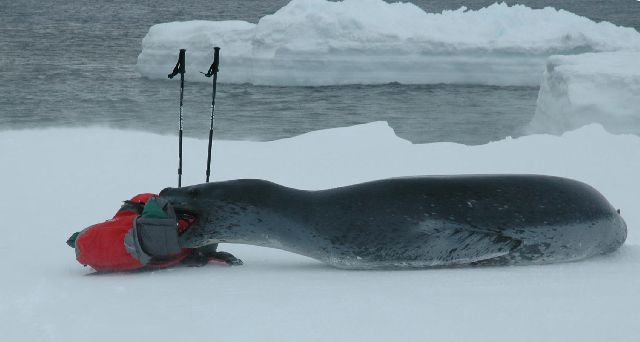 Leopard Seal Playing and Exploring a Bag it found on the ice. Ain't it cute? |
|
Leopard seals are found in the waters around the Antartic and Sub-Antartic continent. They are also found in the southern coasts of Africa
and Australia and small islands surrounding it.
|
 This is where Leopard Seals are generally found, though they can also be seen elsewhere. |
|
Two of the most famous appearance of the leopard seal were in the children movies Happy Feet and The Pebble and the Penguin. In Happy Feet, the leopard seal {Roger Rose} ambushes the main character, Mumble, in the hopes of a meal. He rips some feathers off the penguin's tail, but does no more damage. A seal of few words, he only said two lines when he was land-bound. Enraged by the teasing Adelie penguins, he tries repeated to lash out at them. But he gives up and returns to the sea to find an easier meal, though he did imply another attack with the line: "Remember Dumplings, I know where you live." Despite that, he makes no more appearances. In The Pebble and the Penguin, the leopard seal has no lines, but plays the role of being the penguin character's main predator. Unlike the leopard seal of Happy Feet, this seal makes multiple appearances. Most are wild chases, one of which seperated the main character, Hubie, from the other penguins and into a human zoo ship. He also provided Hubie a practice at the moves he needed to defeat his rival, Drake. |
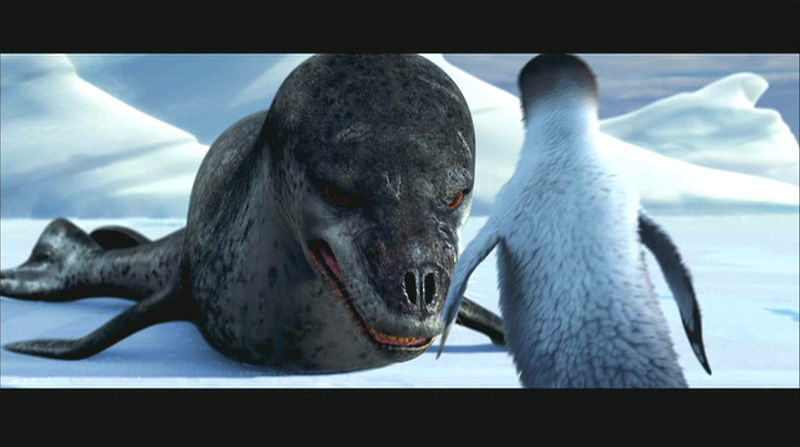 One of my favorite characters in Happy Feet. "Come here, Sausage....I take you with ketchup." |
 A Leopard Seal is just chillin on the ice. These seals fear nothing and are only fed on by orcas. |